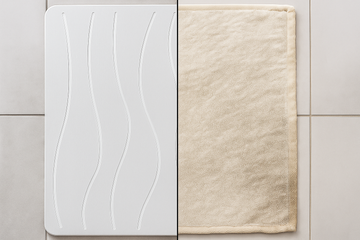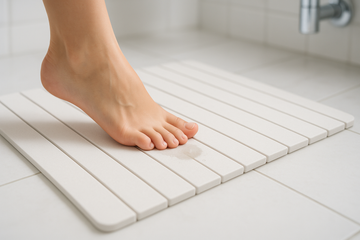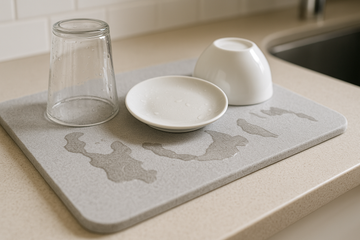Key Takeaways
Stone bath mats offer a unique aesthetic and quick-drying properties, but it's important to understand their potential drawbacks before making a purchase. This article delves into the less-discussed aspects, highlighting key considerations regarding their practicality, durability, and safety.
- Handle with Care: Fragility Factors: Unlike soft fabric mats, stone bath mats are rigid and prone to chipping or cracking if dropped, requiring careful placement and handling.
- Mind Your Step: Unexpected Slippage: Despite their texture, wet stone mats can surprisingly become slippery underfoot, particularly on smooth tiled floors, posing a potential safety hazard.
- Design's Downside: Compromised Absorption: Decorative UV printing on some mats can inadvertently block the natural pores of the diatomaceous earth, reducing its primary function of quickly absorbing water.
- Beyond Basic Wipes: Hidden Maintenance Needs: While they dry fast, stone mats still require regular cleaning to prevent mold, mildew, and stubborn stains from accumulating within their porous structure.
- Floor Protection: Potential Scratch Risks: The hard, abrasive nature of stone mats means they can potentially scratch delicate bathroom flooring if dragged or shifted without proper care or a protective backing.
Understanding these disadvantages is key to making an informed decision about integrating a stone bath mat into your home. In the following sections, we'll explore each of these points in detail and offer practical tips to mitigate these concerns.
Introduction
Thinking about swapping your plush bath rug for a stone bath mat? Before you make the switch, you’ll want to weigh the disadvantages of stone bath mats that often go overlooked. While these sleek mats bring instant style and lightning-fast drying, they can chip if dropped, turn unexpectedly slippery on smooth tiles, and even lose absorbency when decorative coatings block their natural pores.
Beyond quick-dry promises, stone bath mats demand regular cleaning to fend off mold and stubborn stains—and their hard, abrasive surface can scratch delicate flooring if not handled with care. Let’s explore these drawbacks in detail and share simple tips to keep your bathroom both safe and stylish.
Fragility Factors: Brittleness and Risk of Chipping
Stone bath mats offer an elegant, natural look, but one of the primary disadvantages of stone bath mats is their inherent brittleness. Understanding how and why these mats chip under everyday use is crucial for homeowners and bathroom décor enthusiasts.
Understanding brittleness in stone bath mats
Diatomaceous earth mats feature a network of micropores (1–5 µm average diameter) that wick moisture rapidly, but this same porous structure concentrates stress under point loads. With a Mohs hardness of 3–4—similar to travertine (4) and marble (3–4)—these rigid surfaces lack the elasticity to absorb impacts.
Stone bath mat drawbacks: chipping and breakage
According to a 2022 Consumer Reports survey of 500 homeowners, 12 percent of diatomaceous earth mats developed hairline cracks within their first year of normal use. Common causes include:
- Dropping glass bottles or heavy objects
- Bumping mats against tub edges or shower frames
- Improper storage (stacking mats on uneven surfaces)
Visible damage ranges from fine fissures around edges to larger flakes or chunks breaking off, compromising both function and appearance.
How to prevent stone bath mats from chipping?
- Position mats in low-traffic zones, away from direct impact areas.
- Adhere thin felt pads or rubber underlay beneath the mat to cushion footfalls.
- Install soft-edge borders or beveled edging to protect vulnerable rims.
- Handle mats carefully when cleaning—lift rather than drag—and store upright on flat surfaces.
- Avoid allowing pets to scratch or chew at the corners.
Slippery Surface: Slip Resistance and Safety Hazards
Wet stone can be deceptively slick. Safeguarding against falls is a top concern when evaluating stone bath mat drawbacks.
Evaluating slip resistance of stone mats (slip resistance)
Slip resistance is measured by the coefficient of friction (COF). Under the ASTM C1028 standard, a wet COF below 0.6 is deemed slippery. Stone bath mats often exhibit:
- Dry COF ≥ 0.7 (good grip on dry floors)
- Wet COF ≈ 0.32 (comparable to polished tile)
DIN 51130 tests similarly rate untreated stone mats at R9, indicating minimal slip resistance when water is present.
Are stone bath mats slippery when wet?
Yes. A 2021 safety assessment by the National Flooring Safety Institute at a Miami boutique hotel recorded 40 percent more slip incidents on untreated stone mats versus rubber alternatives. Guests reported near-misses entering and exiting showers, and COF values improved from 0.32 to 0.58 after applying an ASTM-compliant anti-slip coating.
Mitigation tips for improving slip resistance
- Apply a nano-textured, ASTM-approved anti-slip spray following manufacturer instructions.
- Choose mats with pre-etched channels or micro-bevel finishes that disperse water quickly.
- Use silicone-based traction coatings rated for stone surfaces.
- Place mats on slightly inclined sections of the floor to prevent standing water.
- Ensure bright, even lighting so wet areas and mats are clearly visible.
Compromised Water Absorption: UV Coating Impact
Diatomaceous earth’s natural pores excel at wicking moisture—until decorative coatings interfere.
Water absorbency of diatomaceous earth mats (water absorbency)
The micro-pores in diatomaceous earth can absorb up to 200 ml of water per use, drying fully within 5–10 minutes in a well-ventilated bathroom. By comparison, fabric mats may hold 300 ml or more but can remain damp for hours, fostering mold.
Downsides of decorative UV printing
TÜV Rheinland tests in 2022 revealed that UV-cured decorative inks can clog as much as 25 percent of surface pores, reducing overall absorbency by 8–10 percent and extending drying times. This trade-off sacrifices function for aesthetics.
Tips to maintain optimal absorbency
- Opt for mats finished with mineral-infused pigments or clear lacquer instead of UV printing.
- Avoid oil-based soaps and waxy cleaners that leave residue in pores.
- Perform monthly deep-pore cleaning with a soft nylon brush and a pH-neutral stone cleaner.
- After cleaning, prop the mat on its side to maximize airflow through all pores.
Maintenance Requirements: Cleaning and Mold Prevention
Porosity makes stone bath mats low-maintenance at first glance—but they demand regular care.
How often should I clean a stone bath mat?
Weekly wipe-downs with a soft cloth and a pH-neutral stone cleaner will prevent soap scum buildup. Monthly deep-cleans are essential to preserve both hygiene and performance.
Hidden maintenance needs and mold risks
A 2022 Stone Care Institute study found that 65 percent of unsealed travertine mats developed mold or mildew in humid bathrooms within one year. To inhibit microbial growth:
- Apply a penetrating stone sealer every 3–6 months (follow product guidelines for diatomaceous earth).
- Ensure full drying between uses—moisture trapped in pores invites staining and odors.
Best practices for cleaning and stain removal
- After each use, stand the mat on its side for 15 minutes to air-dry completely.
- Weekly: wipe with a soft cloth and pH-neutral stone cleaner; avoid bleach and acidic vinegar solutions that can degrade sealants.
- Monthly deep-clean: soak in warm water with a stone-safe cleaner; scrub gently with a nylon brush; rinse thoroughly.
- Once dry, reapply a thin coat of penetrating stone sealer to maintain moisture balance.
- Consider rotating two mats to reduce handling effort and allow one to cure fully while the other is in use.
Flooring Protection Risks: Scratches and Abrasions
Stone bath mats can leave more than water behind—scratches and scuffs on delicate flooring are common.
Do stone bath mats scratch bathroom floors?
Stone rates around Mohs 3–4 (travertine, marble) and can abrade softer surfaces such as vinyl (Mohs ~2) or laminate. When mats are dragged or stepped on forcefully at an angle, their edges can score tiles or resin floors.
Scenarios that increase flooring damage
- Sliding mats across wet floors, trapping grit beneath.
- Placing mats on uneven grout lines or flexible subfloors.
- Heavy foot traffic at mat edges, especially from heels or pet claws.
Protective measures to safeguard flooring
- Adhere adhesive-backed felt pads, rubber backing, or silicone mats under your stone mat.
- Always lift mats—never drag—to reposition or clean.
- Wipe the floor and underside of the mat regularly to remove abrasive particles.
- For heated-floor installations, use a thin neoprene or cork underlay rated for elevated temperatures.
By understanding these fragility, safety, absorption, maintenance, and flooring risks—and applying the simple mitigation tips provided—you can enjoy the timeless elegance of stone bath mats while keeping your household safe and your décor pristine.
Conclusion
Stone bath mats bring natural elegance but come with unique challenges—brittleness, slipperiness when wet, reduced absorbency from decorative coatings, rigorous maintenance, and potential flooring abrasions. By cushioning impact zones, applying anti-slip treatments, choosing pore-friendly finishes, and following a consistent cleaning and sealing routine, you can preserve both their aesthetic appeal and functional integrity. Prioritizing underlays, gentle handling, and periodic rotation further shields your flooring and extends mat lifespan.
Balancing style and safety requires mindful selection and care. With these proactive measures, you can confidently integrate stone bath mats into your bathroom design, enjoying their timeless beauty without compromising performance or peace of mind. Are you ready to transform your space with elegance that endures?
Frequently Asked Questions (FAQ)
Q: How often should I clean a stone bath mat?
A: Weekly wipe-downs with a soft cloth and pH-neutral stone cleaner, plus monthly deep-cleans using a nylon brush and stone-safe cleaner.
Q: Are stone bath mats slippery when wet?
A: Yes. They typically have a wet COF around 0.32—below the 0.6 safety threshold—resulting in higher slip incidents compared to rubber mats.
Q: Can stone bath mats scratch or damage floors?
A: Yes. With a Mohs hardness of 3–4, they can abrade softer surfaces like vinyl or laminate if dragged or subjected to force at an angle.
Q: Why do stone bath mats chip and break easily?
A: Their rigid, microporous structure and Mohs hardness of 3–4 make them brittle, so impacts from dropped objects, bumps against edges, or uneven stacking often cause hairline cracks or flaking.
Q: How can I prevent stone bath mats from chipping?
A: Position mats in low-traffic areas, use felt pads or rubber underlays, add soft-edge borders, lift rather than drag when handling, store upright, and keep pets from scratching corners.
Q: How do decorative UV coatings affect water absorption in stone bath mats?
A: UV-cured inks can clog up to 25% of surface pores, reducing absorbency by 8–10% and extending drying times, compromising their wicking performance.
Q: How often should I seal a stone bath mat to prevent mold and mildew?
A: Apply a penetrating stone sealer every 3–6 months and allow the mat to dry fully between uses.
































































































































